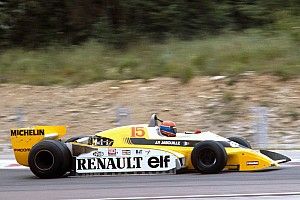Renault Sport F1 on Silverstone
Turbos will return to Silverstone for first time in 25 years this year.

Photo by: XPB Images
Rémi Taffin, Renault Sport F1 head of track operations
Silverstone is one of the most interesting circuits from a Power Unit point of view. Over the years it has become known as a power track and this year will be no different with the hybrid units. In fact the high torque, low downforce cars should produce even quicker speeds than we have seen in previous years.
Over 60% of the circuit is taken at full throttle; in fact from Luffield to Stowe the ICE, turbo and MGU-H will be flat out for a total of almost 40secs. After going through Luffield the driver will accelerate down the old pit straight, reaching speeds of well over 310kph before a short lift off for Copse. The time taken from the driver lifting off to being fully back on it again is less than one second. The challenge for Renault’s engine engineers is therefore to allow the engine to effectively function as a switch, going from “fully off” to “fully on” almost instantaneously.
After Copse the car will have another 10secs of wide open throttle before the high speed turns of Maggots and Becketts. Enormous pressures will go through the internals here as the driver shifts from side to side at an average of 200kph. Then it’s back on the gas for another 15secs down the Hangar Straight. The only other place we will see this long distance of open throttle is Spa. We’ll be looking to the MGU-H to feed the MGU-K throughout this period of acceleration, not only to increase top speed but also to reduce fuel consumption.
The Wellington Loop complex will give opportunity for the MGU-K to recover energy through braking and recharge the battery. In fact this new complex is a blessing for the new PUs since the percentage of wide open throttle and quick corners would otherwise make this a very tricky race to manage in terms of the 100kg fuel limit.
It’s always a pleasure to visit Silverstone. The crowds are always huge and very passionate and knowledgeable about the sport, plus we have the added bonus of being on the home ground for three-quarters of our clients. Equally it is particularly poignant to be back here with the turbo engines after Renault debuted the first-ever F1 turbo back in 1977. We are going there in a positive frame of mind. It’s fair to say that Austria was frustrating and disappointing but we’ve looked at every scenario in a very detailed manner and are confident the failures won’t happen again. There have been changes on two levels; both technically in terms of software evolution and in terms of procedures to ensure we catch an issue before it becomes a major problem. We go there with a clean sheet of paper.
News from Total
Limiting internal engine friction can improve performance and unleash power. Lubricant viscosity plays a decisive role by determining the performance of the moving parts such as the crankshaft, connecting rods and pistons. The oil film that coats the junctions between metal parts must be sufficiently robust to ensure high speed motion without contact. The physical constraints the mechanical parts and lubricants are subject to are infinitesimal: some are separated only by a few thousandths of a micron!
The Return of the Turbo!
Turbos will return to Silverstone for first time in 25 years this year. In 1977 Renault created F1 history when it debuted the revolutionary and highly experimental RS01 at the British GP on 17 July 1977. It became the first-ever manufacturer to race a turbocharged car in the championship. An option for 1.5-litre V6 turbocharged engines has been in the rules for many years but most teams were running 3.0-litre normally aspirated engines.
Frenchman Jean-Pierre Jabouille became the first driver to ever compete in a championship race with the EF01 turbocharged engine locked into the back of the distinctive yellow and white car. The car retired after 16 laps but not before it had made a big impression. Just two years later the RS01 scored its first win on home ground in the 1979 French GP at Dijon. A move to twin turbos, improvements in cooling and reductions in vibrations and friction allowed power and speeds to reach unprecedented levels, with more than 1,000bhp seen on race day and 1,300bhp in qualifying by the mid-80s – just seven years after the turbo made its first appearance.
Renault Sport F1
Be part of Motorsport community
Join the conversationShare Or Save This Story
Subscribe and access Motorsport.com with your ad-blocker.
From Formula 1 to MotoGP we report straight from the paddock because we love our sport, just like you. In order to keep delivering our expert journalism, our website uses advertising. Still, we want to give you the opportunity to enjoy an ad-free and tracker-free website and to continue using your adblocker.














Top Comments